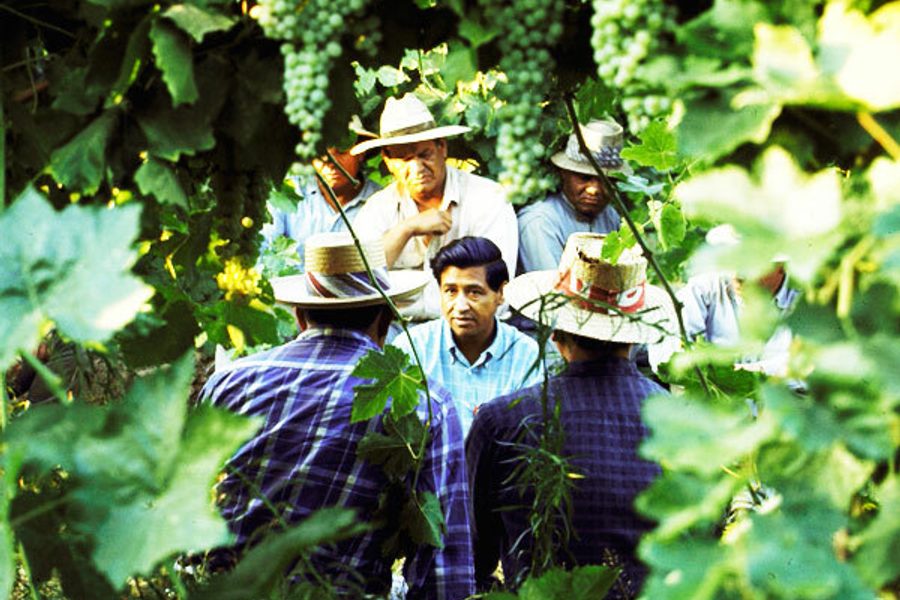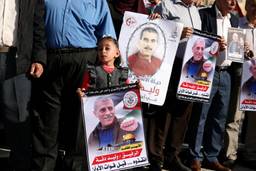Why David Sometimes Wins
Barack Obama is indebted to Cesar Chavez’s trailblazing community organizing strategies.
Ethan Porter

Barack Obama’s victory last November, improbable though it was, did not come out of nowhere. Rather, his campaign was indebted to the lessons and traditions of community organizing. Of course, before he became a politician,Obama organized the churches of Chicago’s South Side. But there’s a longer lineage. If the new book by organizing guru and former Obama advisor Marshall Ganz is any indication, it’s clear that the Obama campaign was influenced by the 1960s and 1970s organizing efforts of Cesar Chavez.
In Why David Sometimes Wins: Leadership, Organization, and Strategy in the California Farm Worker Movement (Oxford, June), Ganz details how Chavez emerged from nowhere to lead the fight to unionize farm workers. The similarities between Chavez’s campaign strategy and Obama’s are striking. You could say that Chavez provided Obama with a first draft.
Ganz’s personal history and strategic insights make his argument for him. In 1964, Ganz dropped out of Harvard, and a year later he joined Chavez and the National Farm Workers Association in California, where he soon ascended the leadership ranks. Decades later, things came full circle when Ganz returned to Harvard as a teacher, preaching the gospel of organizing to the American elite. In the summer of 2007, he was recruited by the Obama for America campaign. At several “Camp Obama” retreats for staffers and allies, he explained the principles of community organizing – principles that would later lead Obama to victory against Hillary Clinton and then John McCain.
Why David Sometimes Wins is a look back as well as a look forward. Ganz recounts the gripping story of Chavez and the farm workers and synthesizes Chavez’s lessons to explain why the farm workers triumphed against the odds. He distills community organizing to its most fundamental, and effective, principles.
Ganz places special weight on the biblical story of David and Goliath, in which David, the meek shepherd, defeats the hulking soldier Goliath. In Ganz’s telling, David prevails not by emulating Goliath, but by wisely using the tools that are available to him. While Goliath arrogantly depends on his physical strength, the strategically cunning David shoots Goliath down with a stone. The moral: A well-implemented, original strategy can overcome innate disadvantages.
“The likelihood that a leadership team will devise effective strategy depends on the depths of its motivation, the breadth of its salient knowledge and the robustness of its reflective practice,” Ganz writes. At the height of its success, Chavez’s team combined all three. Since the turn of the 20th century, efforts to organize farm workers had not achieved lasting change. The workers – who were exempt from many labor law protections – faced brutal poverty. They worked without anything resembling a contract and faced exploitation by farmers and ranchers. A child of migrant workers himself, Chavez was so deeply committed to the cause that he often worked for little or no money. He often convinced his team to follow suit; they had to “suffer” for the cause, he would say.
The National Farm Workers Association (which would later become the United Farm Workers) coupled their motivation with a keen awareness of the farm worker community’s character. Unlike previous attempts to organize workers, Chavez’s union colored its efforts in overtly religious themes. Our Lady of Guadalupe, a Mexican religious symbol, was a fixture in the union’s promotional materials; during one strike, when the court prevented NFWA from picketing, the union held a religious vigil instead.
Finally, the union’s “reflective practice” was robust. Chavez held townhall-style meetings among union members, and in leadership meetings he demanded input from everyone. For the NFWA, “open deliberation” were words to live by.
The results, for a few fleeting years, were pure glory. Despite having minimal experience, the NFWA improvised its way to a 1970 victory against the powerful grape growers of Delano, Calif., from whom they elicited a contract and a pay raise due in part to Chavez’s mastery of drawing support from the establishment. Sen. Robert Kennedy (D-N.Y.) famously pledged his solidarity, as did California Gov. Pat Brown. The union later rode their momentum to another victory over the storied DiGiorgio Fruit Corporation. The legend of Cesar Chavez as a champion of the poor and downtrodden was enshrined in the national consciousness.
The analogies between Chavez’s campaign and Obama’s are numerous. Both faced dual Goliaths – Obama had Clinton and McCain, while Chavez had Teamsters bent on encroaching upon his territory, as well as the farm owners. And both turned their disadvantages into advantages. What they lacked became the reason why they won.
Obama began the primary race as an outsider, with few connections to big money donors and with the powerhouse consultants in the Democratic Party on the other team. Out of necessity, he cultivated an army of grassroots donors who provided him an overpowering edge against the initially better-funded Clinton. Clinton’s consultants, meanwhile, suffered from the blinding overconfidence common among Goliaths. They focused on winning the popular vote in expensive states, while Obama’s campaign concentrated on capturing the delegate count, which gave him the edge and the nomination.
Chavez, too, started as the quintessential outsider. The Teamsters were far better funded and established, and the growers had squashed every organizing effort for decades. But the Teamsters had little working knowledge of what made farm workers tick, using the same methods in the fruit fields of California as they did everywhere else. The growers were just as clueless about the tide of grassroots opposition that Chavez had generated. During a 1973 strike, 17 million Americans boycotted food such as wine, lettuce and grapes in solidarity with the workers.
By the end, both Obama and Chavez were more than merely leaders of a campaign – they inspired movements. They electrified their supporters, who were willing to devote extraordinary amounts of time and money in the name of a larger cause (or, in Chavez’s case, ¡la causa!).
Their opponents, on the other hand, relied on hired help, whose primary objective was not to change the world or even to win, but simply to get paid. Sure, Obama had hired staff – but again, he followed the Chavez model and blended his top leadership levels with campaign veterans and amateurs. He mixed establishment figures like David Axelrod with countless operatives who lacked presidential campaign experiences (memorably resulting in a Che Guevara poster found hanging up in an Obama office.)
Even Obama’s widely admired advances in Internet campaigning seem descended from what Ganz sees as the Chavez model. Obama’s “MyBO” webpage, a self-sustaining social network, connected supporters from across the country to discuss, encourage and, at times, criticize the candidate. It became an extreme sort of “robust reflective practice” – sometimes too robust, such as when the site’s users united against a particular stance of Obama’s. But this only further fueled his supporters’ motivation. Moreover, it provided the campaign a treasure trove of information about his supporters. The “salient knowledge” that Obama had of those he was attempting to organize came in the form of addresses, phone numbers and warm bodies for “get out the vote” efforts.
The strategic approach outlined by Ganz drove both Chavez and Obama to victory. But what happens after such a victory – what happens when David becomes Goliath? Does he become arrogant and tactically incompetent? Ganz knows this is a danger: “Remaining David can be even more challenging than becoming David in the first place.”
For Chavez, the challenge proved too great. After the NFWA’s initial historic wins, later successes were hard to come by. Under Chavez’s late-period leadership, the union turned inward and Chavez-centric: He installed friends in key leadership positions and went on periodic purges against those he deemed “disloyal.” In 1977, the union stopped organizing altogether. It’s still around today, but wages in the California agricultural industry are actually 20 to 25 percent lower than what they were in the early 1970s. Ganz concludes, “The living and working conditions of California farm workers are little better at the beginning of the 21st century than when [Chavez] began organizing in the early 1960s.”
Obviously, it’s much too early to reach any conclusions about the efficacy of the Obama presidency. Yet to avoid the fate of Chavez, Obama would be well-served to avoid one thing: entrusting too much to himself. In other words, from Obama’s perspective, it must be tempting to think that his own star power, like Chavez’s, will carry him through many rough patches. It probably will, as it already repeatedly has. Yet after he scores a few too many victories and convinces himself that his personality alone is enough to conquer anything, the public is likely to tire of him. Even after winning, Obama will have to remain humble. To remain Goliath, in other words, you must continue to behave – and strategize – like David.

I hope you found this article important. Before you leave, I want to ask you to consider supporting our work with a donation. In These Times needs readers like you to help sustain our mission. We don’t depend on—or want—corporate advertising or deep-pocketed billionaires to fund our journalism. We’re supported by you, the reader, so we can focus on covering the issues that matter most to the progressive movement without fear or compromise.
Our work isn’t hidden behind a paywall because of people like you who support our journalism. We want to keep it that way. If you value the work we do and the movements we cover, please consider donating to In These Times.
Ethan Porter, the associate editor of Democracy: A Journal of Ideas, blogs for True/Slant and has written for The Nation, The New York Daily News, Politico, and The New Republic.




